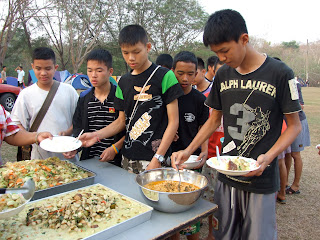http://www.tourismthailand.org/destination-guide/sukhothai-64-1-1.html One of Thailand’s finest warriors, King Ramkhamhaeng made Sukhothai a powerful and extensive kingdom which included many parts of what are today neighbouring countries. A number of ancient cities paid him tribute. King Ramkhamhaeng opened direct political relations with China and made two trips to China - the first in 1282 to visit Emperor Kublai Khan and the second in 1300 after Kublai Khans death.
A major achievement of King Ramkhamhaeng was the revision of various forms of Khmer alphabets into a system suitable for the writing of Thai words. The alphabet that he invented in 1283 was essentially the same as that in use today. A stone inscription reads in part, This Muang Sukhothai is good. In the water there are fish; in the field there is rice. The ruler does not levy a tax on the people who travel along the road together, leading their oxen on the way to trade and riding their horses on the way to sell. Whoever wants to trade in elephants, so trades. Whoever wants to trade in horses, so trades. Whoever wants to trade in silver and gold, so trades.
A total of eight kings ruled Sukhothai. The gradual decline of Sukhothai occurred during the reigns of the last two kings. The end of this first Thai kingdom occurred in 1365 when it became a vassal state of Ayutthaya, a young and rising power to the south. Ayutthaya became the capital of Thailand before Thon Buri and Bangkok. |
Sukhothai was the first kingdom of the Thais in this peninsula. Two princes-Pho Khun Pha Muang and Pho Khun Bang Klang Hao combined their forces and fought the Khmers who commanded an extensive empire throughout this part of the world.
They drove the Khmers out of Sukhothai, a major frontier post of the Khmer Empire, and established it as their capital in 1238. Pho Khun Bang Klang Hao, urged by the people to be king, was enthroned with the royal title of Pho Khun Si Indrathit.

Found in the 13th century, Sukhothai (literally means Dawn of Happiness) was the first truly independent Thai Kingdom, which enjoyed a golden age under King Ramkhamhaeng, credited with creating the Thai alphabet. The superb temples and monuments of this great city have been lovingly restored in Sukhothai Historical Park, a UNESCO World Heritage Site and a must-see for all travellers.




































การเดินทาง
จากตัวเมืองอุตรดิตถ์ ไปตามทางหลวงหมายเลข 1045 (เขื่อนสิริกิติ์-ท่าปลา) ถึงเขื่อนสิริกิติ์ ระยะทาง 58 กิโลเมตร หรือนั่งรถโดยสารจากกรุงเทพฯ ไปลงที่อำเภอเมืองอุตรดิตถ์ และต่อรถโดยสารสายอุตรดิตถ์-ฟากท่า-บ้านโคก รถจะจอดที่หอนาฬิกา ถนนสำราญรื่น หรือจะเหมารถแท๊กซี่บริเวณสถานีรถไฟอุตรดิตถ์ก็ได้
A province in the Lower North, Uttradit has a long history developing through the years since pre-historic time.
The site of the original town, then called Bang Pho Tha It, was located on the right bank of the Nan River. It flourished as a port for goods transportation. As a result, King Rama V elevated its status into a province and re-named it Uttradit, literally the Port of the North.
Uttradit is located 491 kilometres from Bangkok and covers an area of 7,838 square kilometres and is divided into the following districts: Muang, Tron, Laplae, Phichai, Tha Pla, Nam Pat, Fak Tha, Ban Khok, and Thong Saen Khan.



ไม่มีความคิดเห็น:
แสดงความคิดเห็น